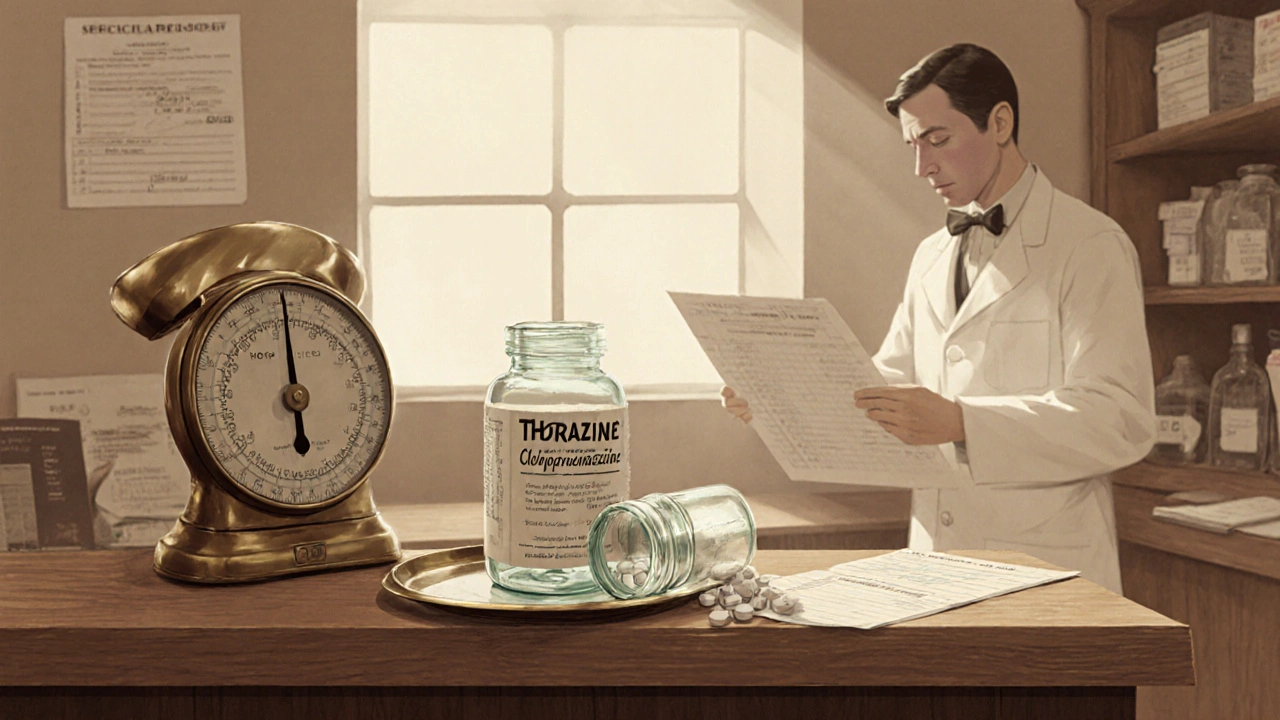Antipsychotic Medication Selector
Recommended Medication:
Why This Choice:
Important Monitoring:
When doctors need to calm severe psychotic symptoms, they often start with a drug that’s been around for decades. Thorazine (chlorpromazine) is that classic choice, but newer medications promise fewer side effects and more flexible dosing. This article breaks down how Thorazine stacks up against the most widely used alternatives, so you can see when the old‑school option still makes sense and when a switch might be smarter.
Key Takeaways
- Thorazine is a first‑generation antipsychotic that blocks dopamine receptors but often causes movement‑related side effects.
- Atypical antipsychotics like risperidone, olanzapine and quetiapine usually have a lower risk of extrapyramidal symptoms but may raise metabolic concerns.
- Haloperidol, another first‑generation drug, is more potent than Thorazine but shares many of its side‑effect challenges.
- Choosing the right drug depends on the patient’s age, medical history, and which side effects they’re willing to tolerate.
- Regular monitoring-weight, blood sugar, and movement disorders-is essential regardless of the medication.
What Is Thorazine (Chlorpromazine)?
Thorazine belongs to the class of first‑generation antipsychotics (also called typical antipsychotics). It works by antagonizing dopamine D2 receptors in the brain, which dampens the over‑active pathways that cause hallucinations and delusions. Approved in 1954, Thorazine was the first drug to bring psychiatric care out of asylums and into hospitals.
Typical dosage: Adults start at 25‑50mg per day, divided into 2-3 doses, with a usual maintenance range of 100‑800mg/day. Elderly patients often need half that amount.
Common uses: Schizophrenia, manic episodes of bipolar disorder, severe nausea, and pre‑operative sedation.
Key side effects: Extrapyramidal symptoms (EPS) such as tremor, rigidity, and akathisia; sedation; orthostatic hypotension; anticholinergic effects like dry mouth; and, with long‑term use, tardive dyskinesia.
Because Thorazine blocks dopamine strongly, it also lowers prolactin levels, which can lead to sexual dysfunction or menstrual irregularities.
Major Alternatives to Thorazine
Newer drugs fall into two broad families: other first‑generation agents and the newer atypical (second‑generation) antipsychotics. Below are the most common choices.
Haloperidol
Haloperidol is a high‑potency, first‑generation antipsychotic. It blocks dopamine receptors more tightly than Thorazine, so lower doses (2‑10mg/day) often achieve the same symptom control.
Side‑effect profile mirrors Thorazine’s EPS risk but with less sedation. It’s a go‑to for acute agitation and in emergency settings.
Risperidone
Risperidone is an atypical antipsychotic that combines dopamine antagonism with serotonin 5‑HT2A blockade. This mix reduces EPS while still controlling psychosis.
Typical starting dose is 1‑2mg/day, titrating up to 4‑6mg for most adults. It can cause mild weight gain and occasional prolactin elevation.
Olanzapine
Olanzapine is another atypical agent known for strong efficacy against both positive and negative symptoms of schizophrenia.
Usual dose range: 5‑20mg/day. The biggest drawback is metabolic side effects-significant weight gain, increased cholesterol, and higher diabetes risk.
Quetiapine
Quetiapine offers a milder dopamine block and pronounced antihistamine activity, making it useful for patients who also need sleep aid.
Doses start at 25mg nightly, climbing to 300‑800mg for psychosis. Side effects include sedation and potential metabolic changes, but EPS risk is low.
Side‑Effect Comparison Table
| Medication | Drug Class | Typical EPS Risk | Metabolic Impact | Sedation Level | Special Considerations |
|---|---|---|---|---|---|
| Thorazine | First‑generation | High | Low | Moderate | Orthostatic hypotension, anticholinergic effects |
| Haloperidol | First‑generation (high potency) | High | Low | Low | Excellent for acute agitation |
| Risperidone | Atypical | Moderate | Low‑moderate | Low‑moderate | May raise prolactin |
| Olanzapine | Atypical | Low | High | Low‑moderate | Monitor weight, glucose, lipids |
| Quetiapine | Atypical | Low | Low‑moderate | High (sleep‑inducing) | Good for comorbid insomnia |
How to Choose Between Thorazine and Its Alternatives
Think of the decision like picking a car. Thorazine is the reliable, older model that gets you where you need to go but may rust faster. Newer models (atypicals) have better fuel efficiency and smoother rides but sometimes come with hidden maintenance costs.
Key decision factors:
- Age and comorbidities: Elderly patients are more sensitive to EPS and orthostatic drops, making low‑potency atypicals preferable.
- Side‑effect tolerance: If a patient fears movement disorders, avoid high‑potency first‑generics like haloperidol and Thorazine.
- Metabolic health: Diabetes‑prone individuals should steer clear of olanzapine or high‑dose quetiapine.
- Acute vs. maintenance: For rapid tranquilization in a crisis, haloperidol or even intramuscular Thorazine may be the fastest option.
- Cost and availability: In low‑resource settings, Thorazine remains cheap and widely stocked, while some newer atypicals can be pricey.
In practice, many clinicians start with a low dose of Thorazine for its affordability, then switch to an atypical if side effects become problematic.

Pros and Cons at a Glance
| Medication | Pros | Cons |
|---|---|---|
| Thorazine | Low cost, long‑standing safety data, useful for nausea and sedation | High EPS risk, orthostatic hypotension, anticholinergic side effects |
| Haloperidol | Very potent, fast onset, good for agitation | Similar EPS profile, limited mood‑stabilizing benefits |
| Risperidone | Balanced efficacy, lower EPS, oral and depot forms | Prolactin elevation, modest weight gain |
| Olanzapine | Strong efficacy for both positive and negative symptoms | Significant weight gain, metabolic syndrome risk |
| Quetiapine | Low EPS, helpful for insomnia and anxiety | High sedation, possible metabolic effects at high doses |
Practical Tips for Patients and Caregivers
- Track symptoms daily: Use a simple chart to note any tremor, restlessness, weight changes, or mood swings.
- Schedule regular labs: Blood glucose and lipid panels every 3-6months for atypicals, and prolactin levels if you notice menstrual or sexual changes.
- Never stop abruptly: Taper the dose over weeks to avoid withdrawal or relapse.
- Ask about drug interactions: Anticholinergic meds (e.g., diphenhydramine) can worsen dry mouth from Thorazine.
- Consider formulation: For night‑time anxiety, a low‑dose quetiapine might double as a sleep aid, reducing the need for a separate hypnotic.
Frequently Asked Questions
Is Thorazine still prescribed in 2025?
Yes. It remains on formularies worldwide because it’s inexpensive and effective for acute psychosis, severe nausea, and pre‑operative sedation. However, many clinicians reserve it for patients who can tolerate its side‑effect profile or when newer agents are unavailable.
How does the EPS risk of Thorazine compare to haloperidol?
Both are first‑generation antipsychotics and can cause EPS, but haloperidol is more potent, so lower doses are needed. Thorazine’s EPS risk is considered moderate to high, while haloperidol’s is high, especially at doses above 10mg/day.
Can I switch from Thorazine to an atypical without a washout period?
Usually, clinicians cross‑taper: gradually decrease Thorazine while introducing the new atypical over 2‑4weeks. A washout isn’t required, but close monitoring for relapse or new side effects is essential.
What monitoring is needed for patients on olanzapine?
Check weight, fasting glucose, and lipid profile at baseline, then every 3months. Also watch blood pressure and note any sudden increases in appetite.
Is there a generic version of risperidone?
Yes, several manufacturers produce generic risperidone tablets, making it a cost‑effective alternative to brand‑name formulations.
In short, Thorazine still has a place in the psychiatric toolbox, especially where budget constraints dominate. Yet, if you can afford the newer agents, the atypicals often spare you from the stiff‑necked side effects that make patients wary of staying on medication. The best choice always comes down to personal health profile, side‑effect tolerance, and open communication with the prescribing clinician.
For anyone navigating this decision, start by writing down your top priorities-symptom control, side‑effect avoidance, cost-and bring that list to your next appointment. A clear, data‑driven conversation can help you land on the drug that fits your life best.





Everything pharma pushes is just a way to keep us dependent.